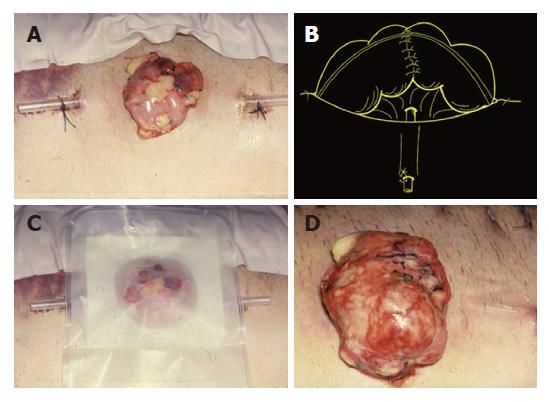Copyright
©2007 Baishideng Publishing Group Co.
World J Gastroenterol. Jun 21, 2007; 13(23): 3215-3220
Published online Jun 21, 2007. doi: 10.3748/wjg.v13.i23.3215
Published online Jun 21, 2007. doi: 10.3748/wjg.v13.i23.3215
Figure 1 A: The colon immediately after primary anastomosis and exteriorization.
This was a blast trauma victim (see ecchymosis of abdominal wall). Note the placement of the drain tube holding the colon, there is enough skin all around to allow for the colostomy bag fixation; B: Schematic representation of the exteriorization technique. Note the exit sites of the sturdy drain tube holding the colon in position. There is enough skin around the colon to allow immediate application of the colostomy bag in theatre; C: The immediate covering of the colon with a colostomy bag in the operating room (same patient as in A); D: The exteriorized colon at d 5, immediately before “drop-back” into the peritoneal cavity. Early serositis and oedema is apparent as compared to the same loop immediately after surgery (A). Delaying “drop-back” beyond this time would worsen the serositis and lead to break down of the suture line or leak after interiorization.
- Citation: Asfar SK, Al-Sayer HM, Juma TH. Exteriorized colon anastomosis for unprepared bowel: An alternative to routine colostomy. World J Gastroenterol 2007; 13(23): 3215-3220
- URL: https://www.wjgnet.com/1007-9327/full/v13/i23/3215.htm
- DOI: https://dx.doi.org/10.3748/wjg.v13.i23.3215









